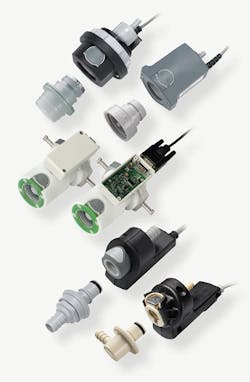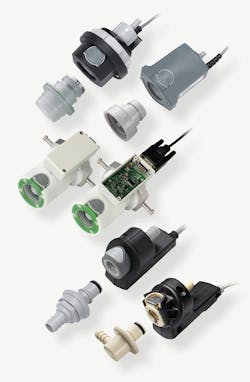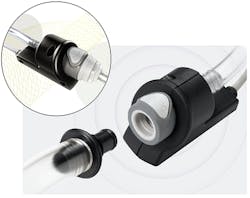The Rise of Intelligent Fluid Connectors
This file type includes high resolution graphics and schematics when applicable.
A new generation of “smart” tubing connectors handles not only fluids, but also the back-and-forth flow of data. These connectors rely on radio-frequency (RF) communication to improve machine performance, prevent human error, and capture fluid and product data.
Connectors that permit communication between fluid lines and machines are quite useful in many critical applications. For instance, they’re often needed in machines that deliver high-value consumables via tubing (from bottles, bags, and other containers or transfer devices) to equipment such as 3D printers or medical laboratory testing machines.
At its most basic, a communicating connector identifies and authorizes the correct connecting port. But beyond preventing simple connection errors, communicating connectors can take on quantitative and qualitative analysis and record-keeping tasks that until now have been left to human operators. For example:
• Does the fluid container being connected contain the brand of consumable for which the machine is designed?
• Is the fluid in the container past its expiration date?
• Is there enough material in the container to complete the process without interruption?
• Has the material been stored under the right environmental conditions?
• How much of the consumable will be left in the container when the process is complete? Communicating connectors can wirelessly transmit such data to a computer or PLC for recording, access, and further analysis. Here’s a closer look.
Communication Basics
A fluid coupler with wireless communication capabilities has two parts: a quick disconnect coupling body that houses an RF reader/writer; and a coupling insert that houses an RF data tag that stores data and communicates with the body. Data on the tag can be continually overwritten and changed when communicating with the reader/writer. The coupling body is usually part of a machine, while the insert is typically part of the fluid container or source.
Application requirements determine when the two connector parts begin communication. At a prescribed distance—most often when the two coupler halves are close but not connected—the reader in the body communicates with the RF tag in the insert. The machine controller determines whether the connection is allowed or disallowed, based on preprogrammed parameters unique to each application. If connection is permitted, additional data specific to the application can flow between the machine and consumable package.
Today’s wireless fluid connectors use a communication protocol similar to the simple radio-frequency-identification (RFID) tags used in many passive product-identification applications. These read-only RFID tags are simple, inexpensive, and most often applied to products to facilitate inventory or packaging processes.
The underlying technology used in intelligent wireless fluid connectors, on the other hand, is more complex and costly. Not only does the coupling body recognize its corresponding insert to prevent misconnections, but it can read and write a variety of data for process validation, process improvement, and record-keeping.
Its use can enhance machine performance, provide valuable operational data, and even reduce labor requirements. In the right applications, the added cost of a communicating coupler is insignificant when weighed against the potential costs of utilizing the wrong connector or the wrong media (see "Real-World Problems for Machine Manufacturers"). In fact, controlling risk is often a major goal in critical commercial, industrial, and medical applications.
Application Benefits
Intelligent fluid connectors with built-in wireless communication offer a wide range of capabilities for critical machine applications involving fluid handling. Some of their potential uses and benefits include:
• Connection validation: This capability ensures correct connections in multiple-port systems because the RF tag tells the controller what is being connected to each equipment port. Detecting an error lets the controller display a warning to the operator or shut down the equipment. Connecting each fluid line to the correct port prevents equipment damage or safety issues.
• Media validation: Proper identification prevents inferior or incorrect consumable media from damaging equipment or the process. It also provides brand protection. The connector reads identification data on the consumable container’s tag, and the controller verifies that approved media is being connected to the equipment.
• Operational control settings: The connector body reader reads the tag on the connected fluid medium and automatically sets operating variables, such as pressure, flow rate, and operating-time duration, to match the specific medium or operation. This reduces the risk of human error in setting operating controls and prevents harm to equipment or the end product.
• General-purpose track and trace: Wireless connectors let the controller maintain an accurate record of process steps—for example, when ingredients are added or mixed, what cultures are used, or when curing is completed. The reader in the connector body writes data to the tag on the fluid container indicating what operation was completed at each step. Automated electronic recording of each process step eliminates human errors and the need for paper process records.
• Consumption control: Intelligent wireless fluid connectors can enforce single use or limited use of consumables. The controller tells the wireless connector to write to the container’s tag after each usage of the product. Upon reaching the threshold, the controller reports that the consumable is at its end of life. The availability of usage data helps reduce the risk of damage to the equipment or process.
• Patient-use track and trace: Intelligent wireless couplers can be used on patient-specific devices, such as blood-pressure cuffs. The connector reader writes patient data and a record of each use to the RF tag on the cuff. The system ensures that the patient gets the correct cuff, tests are performed on schedule, and the cuff has not exceeded its useful life.
Design Considerations
When specifying communicating connectors for a machine design, it is best to work with a company that has wireless communication expertise and application experience. While it may be tempting to handle radio-frequency communication in-house, it is often more time- and cost-efficient to partner with an experienced supplier. Here’s why:
• Components complexity: Although wireless communication is a maturing technology, tag and reader components used in fluid handling must meet specific application demands. Most RF communication devices are designed to sense as far away as possible. In fluid-coupling applications, however, the goal is for the two halves to communicate only when tag and reader are in close proximity.
• Radio-frequency tuning: Dealing with RF noise in the environment is critical to the success of any wireless communication application. The challenge is controlling the distance at which coupler halves communicate.
• Security: Experienced suppliers of fluid connectors with wireless capabilities are familiar with security issues, and help machine builders ensure that products will cope with today’s and tomorrow’s wireless security challenges.
• Integrated components: Machine builders can sometimes source RF/RFID parts from various vendors and assemble them to perform tolerably. However, experienced suppliers of wireless fluid connectors rigorously test the quality of readers, tags, and fluid connectors as a total system. That ensures better overall performance.
• Economics: Proven suppliers of wireless fluid connectors usually purchase components in volume and offer economies of scale not available to one-off users.
Industry and market expertise: Knowledgeable suppliers of wireless fluid connectors understand the current and future trends in the RF market, and can provide forward-looking insights to machine designers and manufacturers.
This file type includes high resolution graphics and schematics when applicable.
The concept of talking fluid connectors is an elegantly simple solution for enhancing machine performance and preventing operator errors. However, the underlying technology is not as simple as it seems. Developing couplers that exchange data wirelessly prior to, or upon, connection requires both connector and RF expertise. Thus, it’s suggested that machine designers considering the benefits of wireless communication seek out experienced component suppliers.
Dennis Downs is Director of Business Development, New Technologies, at Colder Products Co. (CPC), St. Paul, Minn.



